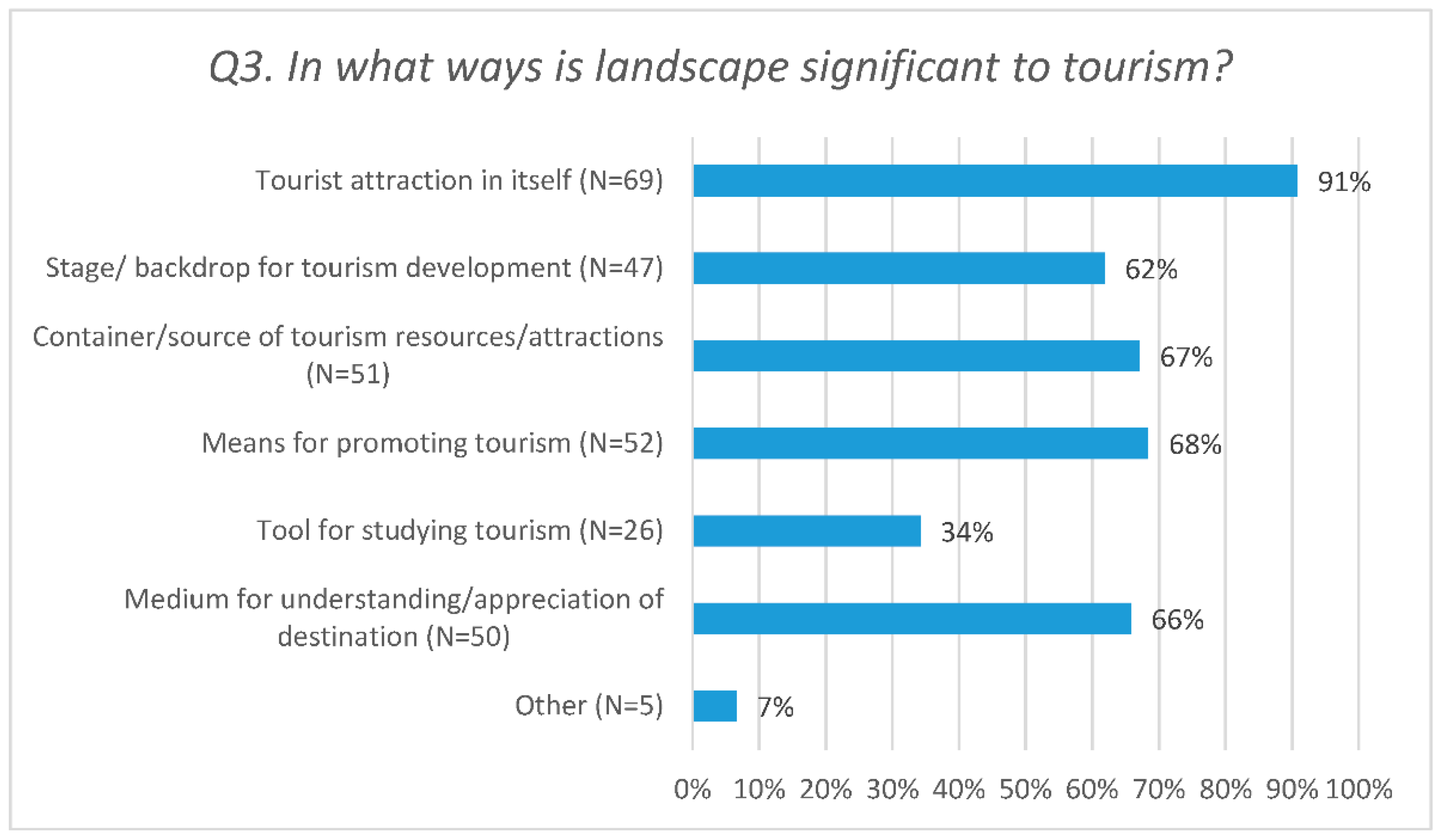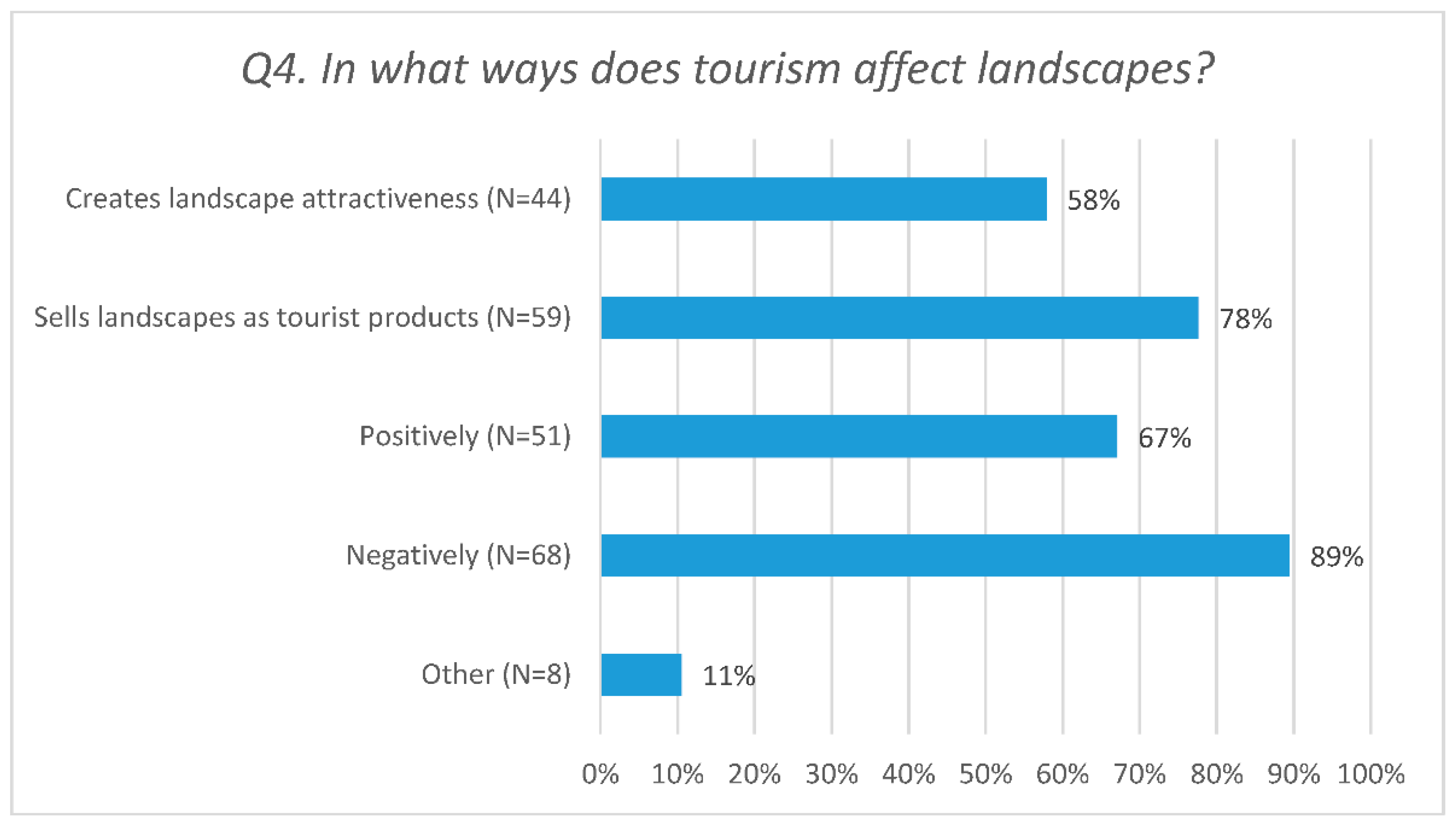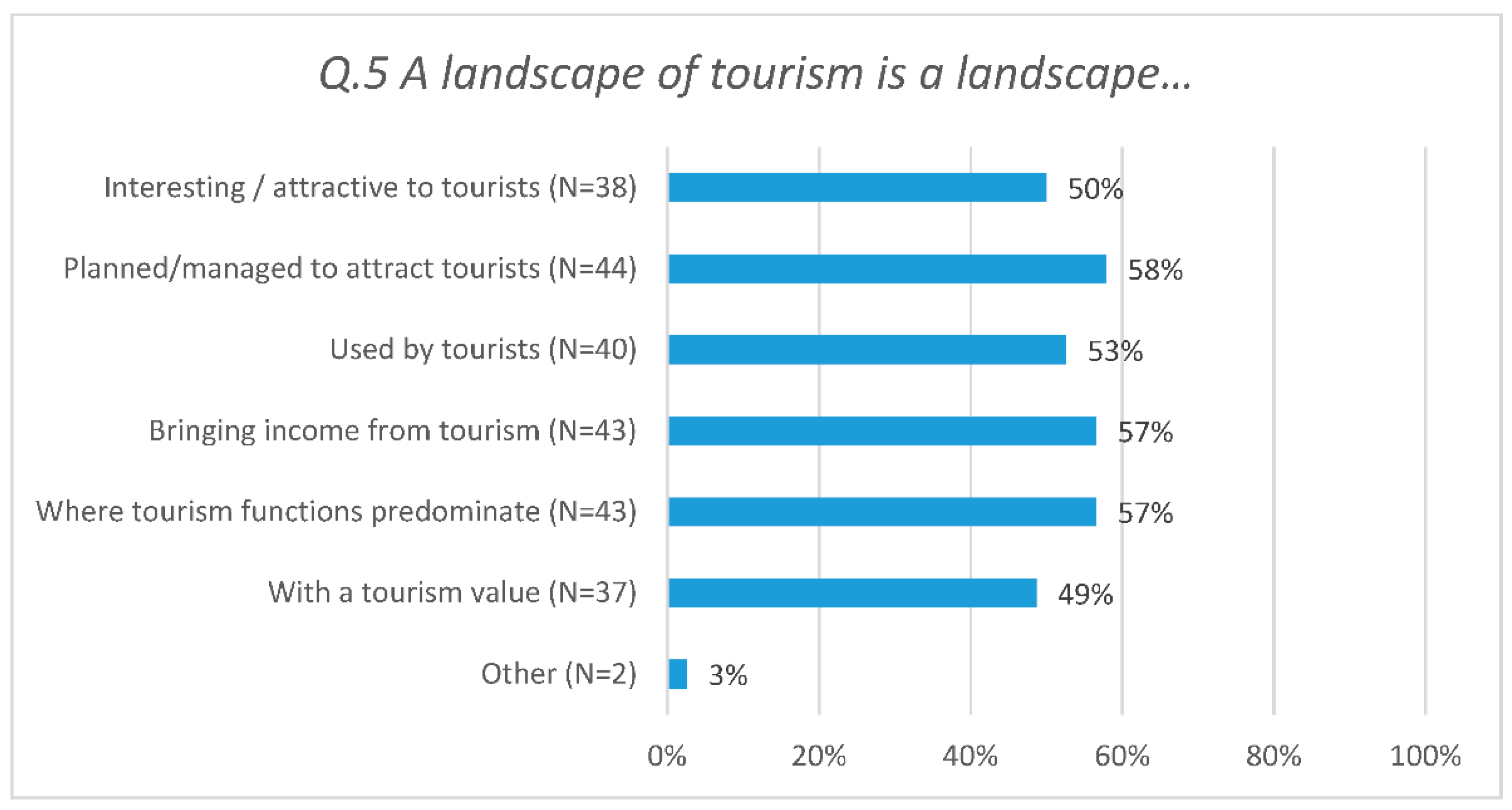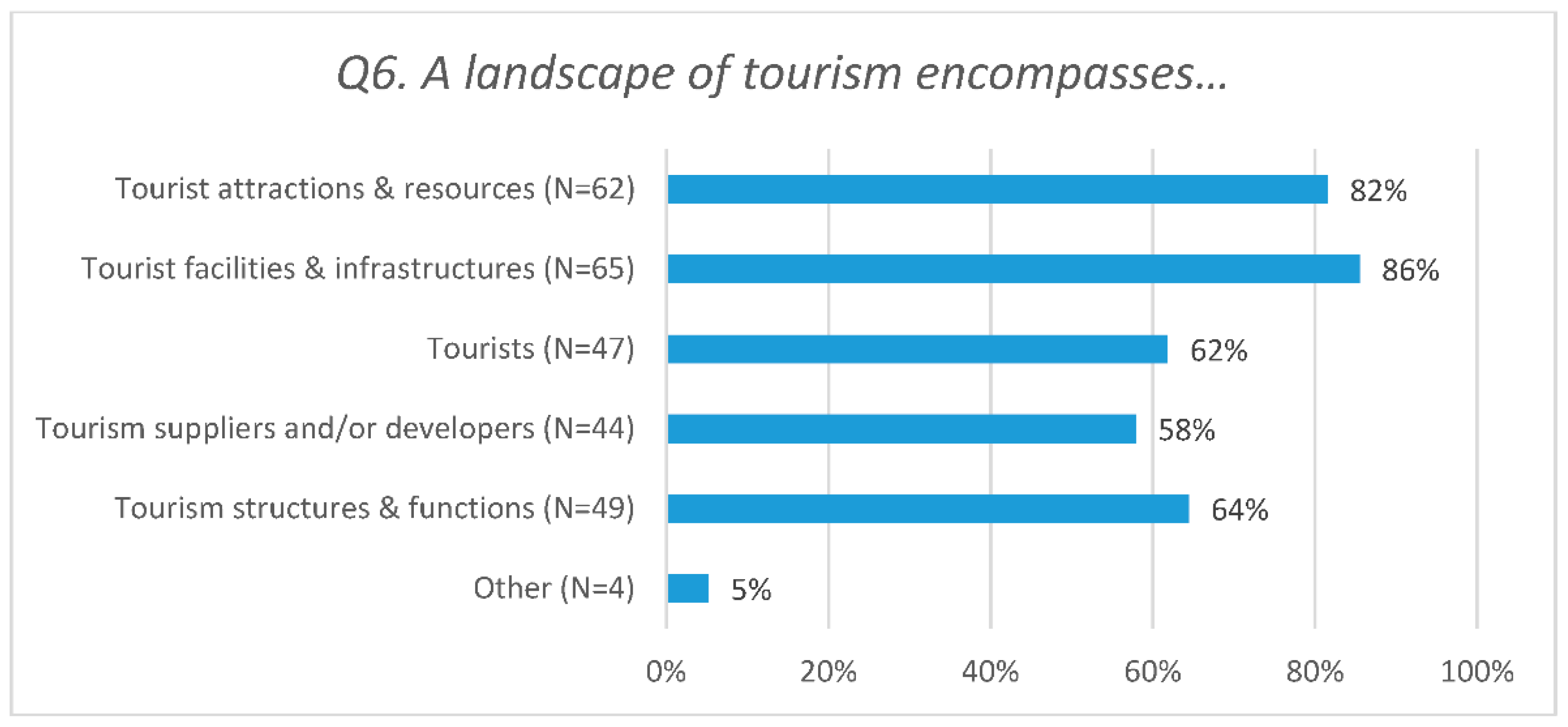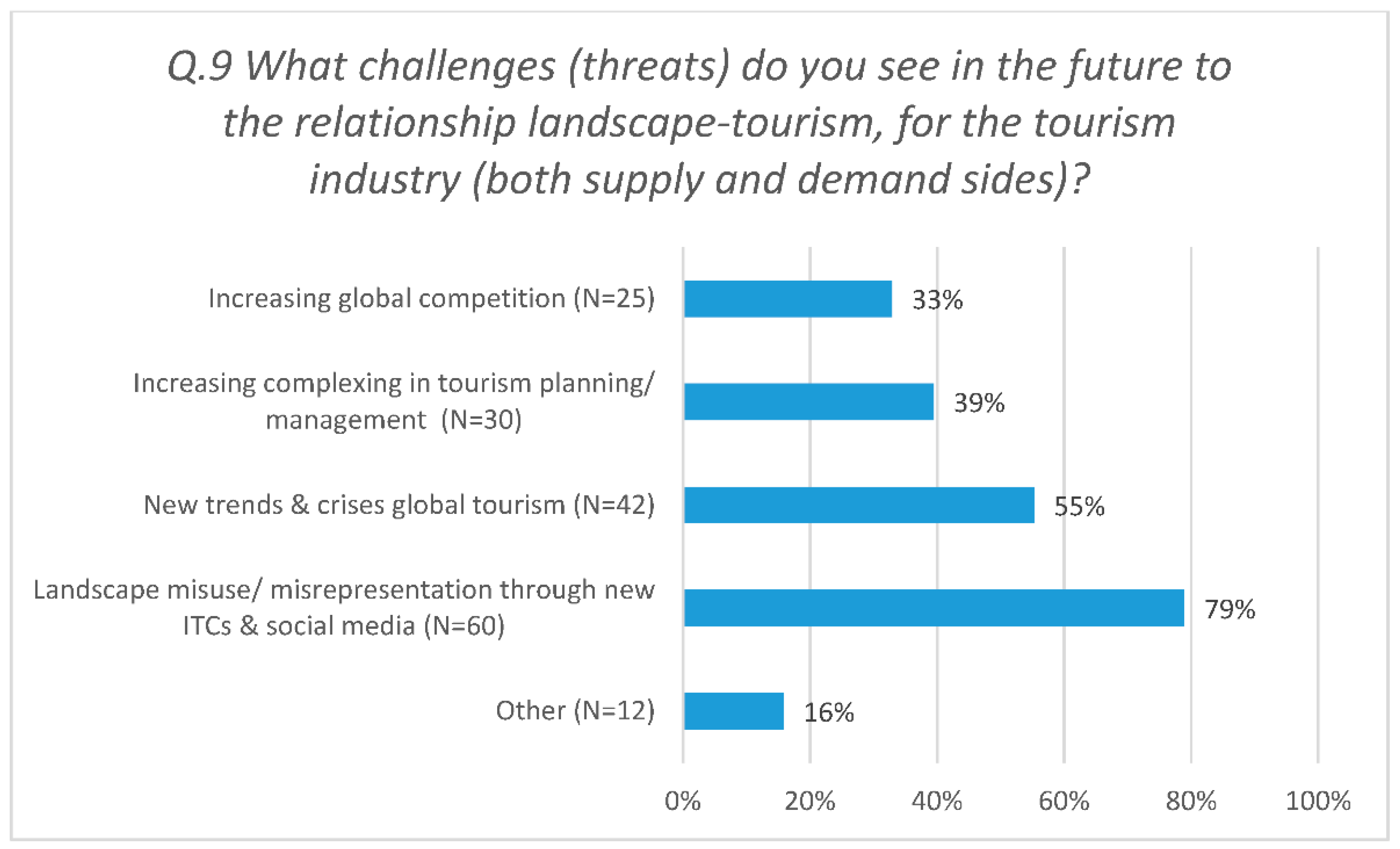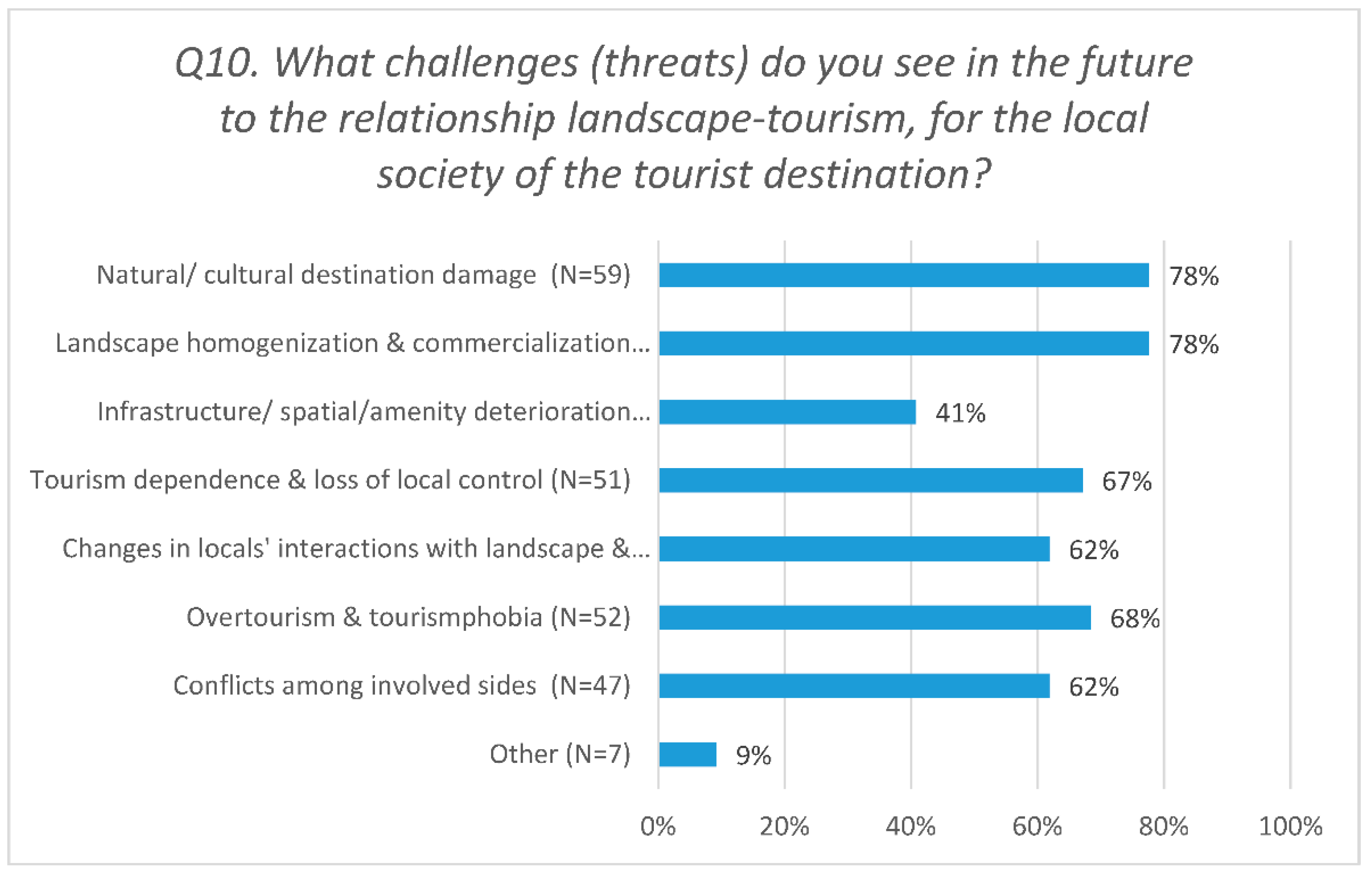1. Introduction
In recent decades, along with the dynamic development of the phenomenon of tourism and of tourism studies, much interdisciplinary research has appeared on the subject of landscape and its transformation through tourism [
1,
2,
3,
4]. At the same time, acknowledgment of the presence and role of the landscape in tourism continues to be scant and tentative overall compared to other fields of tourism-related scientific research, and no adequate organizational framework for analyzing the relationship between landscapes and tourism has so far been developed [
1,
2,
3,
4].
Thus, although the centrality of the landscape to tourism is unquestionable and is already a broadly established scientific area of research, much remains to be explored and understood regarding their interrelatedness. Landscape and tourism—both highly complex and multifaceted—come together in a variety of ways across time, space, and culture [
1,
5]. This research was undertaken in this context, and is designed for, and aiming at, collecting and assessing expert knowledge, information and opinions in Europe on basic and significant facets of this intertwined relationship. Specifically, the objective of our research was to investigate, analyze and assess notions and perceptions of the reciprocal relationship between the landscape and tourism through an electronic survey among European researchers and scientists of relevant and associated academic fields.
For this purpose, our research was carried out via an interview questionnaire with expert respondents focusing on (a) their perceptions, understanding and visions of future optimization of the reciprocal tourism–landscape relationship, (b) their conceptualizations of landscapes of tourism, and (c) their assessments of the prospects (opportunities) and challenges (threats) coming out of the close tourism–landscape relationship for the tourism industry and for the local societies involved.
The aim of this research was mainly to contribute to the scientific understanding of the ways in which tourism destinations function and of tourism-induced changes to the landscape. The obtained results may provide useful input for future planning and management efforts, both in the realm of tourism and in the realm of landscape, as well as aid in the corresponding assessment and stewardship of landscapes in different settings and under different conditions and tourism pressures.
2. The Theoretical Context: A Brief Overview
The significance of the landscape to the variety of experiences sought or unfolding at a visited destination is well-established and considered paramount [
3,
6,
7,
8,
9,
10,
11,
12]. The centrality of sightseeing to tourism and the definition of landscape itself [
13], attest to the fact that there can be no tourism without landscape, and no landscape without a viewer or observer in the broad sense of the term. This fact opens up a broad range of possibilities and options for tourism and landscape planning, management and marketing.
All types of landscapes and places may potentially hold interest for some type of visitor, such as for the consumption of goods, services, activities, and experiences. However, certain types of landscapes in certain parts of the world and at certain times, tend to evolve as much more significant visitor attractors than others. This is often due to the landscape’s unique, spectacular or otherwise attractive and interesting character. There is also ample scientific evidence pointing to the great variability and cultural contingency in landscape visitor perception, preference and appreciation by viewers, users and visitors [
10,
14,
15,
16,
17,
18,
19]. This variability, character and significance of the landscape–visitor relationship, both geographically and historically, remains largely unexplored, especially regarding the role that the landscape plays in the tourist (and generally leisure or recreational) experience. Different types of landscapes tend to offer visitors different services and experiences, such as tranquillity, excitement, education, solace, seduction, awe, inspiration, sense of well-being, homeliness. Contextualized and overarching leisure and tourism experiences increasingly inform and substantiate new types of landscapes of tourism and leisure. The tourist seeks regeneration in the form of pleasure, dreaming, change, tradition, socialization, arts, sports, wellness, or education, and this is prompted by an on-going quest for novel or simply satisfactory tourism–landscape destinations and activities.
Therefore, rising international rates and patterns of mobility and use require a renewed and more in-depth investigation into the desired types of sites and attractions and into the role of the landscape in the visitor experience [
4,
10,
20,
21]. One positive trend in this direction is the enormous proliferation of a broad range of alternative, special-interest and special-purpose forms of tourism, variably (and often, intricately) connected to landscapes. In this context, landscapes are becoming increasingly important as a tourism, recreational or leisure destinations competitively planned, managed and promoted by the supply side. Furthermore, the predominant goals of such endeavors tend to be increasingly compatible with sustainable “green” landscape development for local societies and tourism, while catering to a variety of broadly accessible tourism or leisure pursuits and activities on the demand side [
5,
22].
On the basis of its mediational nature, the landscape represents the primary and most enduring medium of contact between the tourist and the destination. The tourist sets out on a trip, with images, dreams or ideas of the destination. The tourism industry markets images, discourses, resources and uses of landscapes through representations of their cultural signs (e.g., advertising and promoting attractions, digital destination marketing, or city branding. Through the cultural, performative or affective re-interpretation of these signs—either deliberately or inadvertently—the tourist or visitor assesses, validates and uses the meanings and identity of the destination in the context of its landscapes [
23].
Notwithstanding its constitutive ambivalent and contested processes, a cultural landscape becomes a significant ground for personal, cultural or destination change and identity formation [
9]. Furthermore, the connection between landscape and tourism is not restricted to the geographical or physical. It extends also to the performative nature of the travel experience and the pleasure sought in it, as established through theories of emotion, affect, and more-than-representational geographies of human-landscape interaction [
15,
24,
25,
26]. All of these variables come into play when analyzing tourism in the landscape.
Much confusion, however, exists in the scholarly literature around the terms “tourist” and “tourism” in conjunction with the concept of landscape [
3,
4]. The noun “tourism” is intended to depict the processes through which a landscape or landscape activity or development is shaped to serve tourism and tourism landscapes. As a noun or adjective, “tourist” indicates the means by which activities and landscapes are substantiated or used via the phenomenon of tourism. Accordingly, “landscapes of tourism” or “tourism landscapes’ refers to the ways these landscapes are produced, whereas “tourist landscapes” speaks to the ways they are used [
23]. The term “visitor” is often alternatively employed to encompass all types of such intended expropriation of points, areas, or sites of appeal, inciting interest from a broad range of parties, such as tourists, excursionists, day-trippers, explorers or recreationists. [
27].
Contemporary approaches to the landscape–tourist relationship consciously signal multiple and shifting points of view in the context of leisure-economy production and use [
5,
10]. This landscape–viewer relationship, as staged and played out in tourist landscapes, has been increasingly explored in the context of tourism and leisure studies during the past two or three decades (e.g., in the analysis of aspects of tourism destinations as cultural landscapes or in the context of sustainable development). The interface between these two broad and complex areas of scientific study, tourism and landscape, has elicited a varied body of research regarding its nature, focus and approach. Nonetheless, there is, so far, no comprehensive and cohesive theoretical framework to support this body of work. This increasingly interdisciplinary area of study is further compounded by the fact that it is often engaged within the broader context of leisure studies. Nevertheless, interest in it has grown, especially in the last decade, as is reflected in the increase of publications in this field and in research topics dealing with landscape and tourism. However, there are few (teams of) researchers specializing and conducting research consistently in this field, while such publications tend to be widely dispersed among relevant publication outlets [
28].
Few attempts have been made to study tourism or landscape typologies, in order to combine different landscape features and dimensions with types of tourism and destination development [
3,
4,
29]. Many challenges are involved in this task. From the landscape perspective, they not only represent different cultures but are also comprised of different urban, natural, semi-natural or rural ecosystems and settings, which offer a wide range of recreational possibilities that have positive, negative or other implications for the destination, visitors, and tourism. From the recreation and tourism side, more or less generic or unique attractions and respective recreational infrastructure and amenities range from minimally popular to highly sought-after. The relevant literature also cautions against despoiling the landscape through tourism, with the latter often destroying the very basis of its development.
The development of new types of landscapes as new forms of tourism cater to new social needs, cultural preferences and economic contingencies has been an ongoing practice since the advent of the tourism phenomenon. The novelty of such landscapes in the present age, however, lies in their nature, scale and geographical characteristics that cut across many of the more traditional types of tourist or tourism environments. The separation, for instance, of leisure from home life that modernization has brought becomes more and more tentative and irrelevant in the postmodern western world, turning tourism into a ubiquitous practice in the landscape. What we understand as leisure or tourism today has merged with spectacle, where specific pleasures are not place-bound and objects of delight proliferate [
14,
15,
30]. This results in a growing spatial de-differentiation between leisure and tourism and activities like shopping, work, culture, satisfaction of basic needs, comfort, play and familiarity. Thus, in the context of this new cultural economy of space [
5], the increasing tendency is for all landscapes to assume certain characteristics of leisure and tourism, while the distinction between leisure and tourism also becomes increasingly blurred.
3. Results Design and Implementation
The objective of our research was to investigate, analyze and assess notions and perceptions of the reciprocal relationship between the landscape and tourism by means of an electronic survey among European researchers and scientists of relevant and associated academic fields.
For this purpose, we employed the Survey of Expert’s Opinions, an expert (heuristic) method. Such research methods are used in the study of phenomena with a high degree of complexity. They essentially constitute a creative approach to the studied phenomenon, based on creative methods of thinking and problem solving (e.g., detecting new facts and relations) [
31]. The effects of using such heuristic methods are, for example, the ability to determine the intensity of the occurrence of a new phenomenon, determine turning points in the course of a given phenomenon, or determine the probability of a given event. The basic assumption is that the accuracy of group judgements is usually higher than that of individual experts. The expert group should be distinguished according to their professional relationship to the field of the phenomenon in question (from both science and practice), personality, comprehensive knowledge, independent thinking, and different views on the phenomenon [
32]. Thus, in accordance with the procedure of the adopted method, we made a conscious decision to select the most qualified participants at the outset of our study.
The experts were selected on the assumption that they had extensive knowledge of the structure and functioning of landscape and tourism development and that they had an impact on relevant education or strategic planning regarding tourism management. In accordance with the main objective of our study, the core group of respondents consisted of academics. In addition, the group of experts included practitioners from, or representatives of, public management (local government officials, city officials, employees of tourism organizations) and the tourism industry.
Accordingly, using national and international professional networks, we created a database of more than 150 potential expert respondents and compiled the interview questionnaire (
Table 1) to elicit (a) their understanding and visions of future optimization of the reciprocal relationship between the landscape and tourism, (b) their conceptualizations of tourism landscapes, and (c) their assessments of the prospects (opportunities) and challenges (threats) stemming from the close tourism–landscape relationship for the tourism industry and the local societies. The questions were closed-ended (offering multiple choices of responses), except for the first two questions (Q1 and Q2) and the final one (Q11), which were open-ended. For Questions 3 to 10, the respondents could choose more than one answer. Responses to the open-ended questions were de-codified, and all survey results are presented in the following section.
The questionnaire survey was implemented electronically from November 2019 to April 2020, using Google forms on-line. It was sent to all selected experts in landscape and tourism. We received 77 responses, mostly from academics and secondarily from researchers or high-ranking professionals (
Table 2). The vast majority of our respondents came from European countries, and their socio-biographical profile is shown in
Table 2, below.
There seemed to be a predominance of females, while the highest percentage for educational profile belonged to Ph.D. holders, as would be expected in such an expert survey. The age distribution more or less also followed an expected normal curve, and, not surprisingly, the vast majority came from the academic world.
4. Results
The main part of our survey included questions that addressed the interconnections between landscape and tourism and their repercussions. The first two questions were open-ended and their answers were decodified, as shown in
Table 3 and
Table 4.
It was very interesting to note that the distribution of answers among the categories of the decodification was very much in agreement with that of the answers to similar questions that were administered in a subsequent closed-ended form. Specifically, the findings for Q1 (
Table 3) were very similar to those for Q3 (
Figure 1), whereas the findings for Q2 (
Table 4) were very similar to those for Q4 (
Figure 2), and will be discussed together further down. We will follow the same strategy in the presentation and analysis of results pertaining to all similar questions in order to describe and elaborate on the findings in a more comprehensive and relational way.
Concerning the ways in which landscape is significant to tourism (Q1 and Q3) (
Table 3 and
Figure 1), the experts seemed to assign a pivotal role to its tourism–inducing capacity. First, their answers indicated that they saw landscape as a tourist attraction per se. Secondly, they saw it as a container of tourism resources and attractions and a means for promoting a destination. Other possible responses also appeared in our survey data, the least mentioned one being: “landscape is a tool for studying tourism”. For the ways in which tourism affects landscapes (Q2 and Q4), there seemed to be a balance between respondents who said it seems to play a role in creating landscapes and those who said it seems to play a role in selling landscapes (
Table 4 and
Figure 2). Perhaps the most significant finding here was that, despite the fact that tourism was said to affect landscapes both positively and negatively, the negative opinions exceeded the positive ones in both cases (Q2 and Q4).
Nonetheless, it was especially noteworthy to acknowledge the large number and variety of answers we received to all of these questions, both closed-ended and open-ended, whether given by the experts themselves (Q1 and Q2) or as their responses to choices given by our Questionnaire (Q3 and Q4). In other words, all categories of possible responses seemed to enjoy high agreement among the survey participants.
Question 5 addressed the basic issue of the definition of a landscape of tourism (
Figure 3). Despite the fact that the experts’ answers were fairly well distributed among the various alternative categories in this closed-ended question, an interesting tendency emerged. Most answers favoured the supply side of tourism and landscape, which refers to the creation and marketing of such landscapes, rather than the demand side, which emphasizes the use of landscape from the tourists’ side. The emphasis was thus on aspects of the development of tourism in such landscapes (planning and management) and of the outcome and imprint of such processes on the land, namely, a destination landscape where tourism functions dominate other functions (industry, culture, transportation, or other).
These findings were also reflected in the answers we received to (Q6) (
Figure 4). According to our respondents’ understanding of the definition of a landscape of tourism, the it encompasses most significantly features relating to the articulation and development of landscapes to cater to tourists (attractions and resources; facilities and infrastructure). Furthermore, features, resources and facilities of landscapes of tourism received a higher number of quotes, and thus seemed to have more significance for the respondents than did the human and managerial counterparts (tourists and tourism professionals and tourism organizational, institutional and management structures and functions). Such a finding may have reflected the predominantly material (if not visual and generally sensory) character of this unit of analysis, which refers to a spatial entity, the landscape. Certainly, there is much more to a landscape than its materiality or sensory character [
13]; however, the latter properties generally seemed to predominate in landscape definitions and conceptualizations among lay and “expert” populations [
4,
34,
35].
The opportunities and threats that the relationship of tourism with the landscape presents to both the tourism industry and the local destination society were explored in Q7–10. With regard to the opportunities for tourism (Q7), our survey participants favoured “creating a diversified tourism basis and amenities to combine different forms of tourism with the landscape (alternative or special interest)” (
Figure 5). Moreover, they also mentioned two other opportunities to a high degree: “departure from mass tourism and ‘3S’ tourism towards more sustainable, mild, slow or small-scale tourism” and “fostering sustainable overall destination development”. Taking together all three of these types of answers, which comprised the vast majority of answers to Q7, we came to the conclusion that the main opportunities for the tourism side were thought to be the creation of a more diversified and sustainable basis for tourism growth.
Interestingly, the respondents’ suggestions of opportunities stemmed from the relationship of tourism with the landscape for the local destination side similarly revolved around the same principles and lines of thought. Specifically, the answers we received for Q8 (
Figure 6) leaned heavily towards the prospect of furthering all pillars of overall local environmental, social, economic, and cultural sustainability [
36,
37]. The respective responses (categories of opportunities for the local side) that combined to support this conclusion were, in their stated order of significance: “promotion, protection and sensitization vis-à-vis the natural environment, culture and heritage and the destination place”, “offering local societies employment opportunities, local entrepreneurship, financial revenues and other benefits”, “cultivation of cultural identity, place pride and social cohesion in local societies”, and “development of and further investment in local economy (e.g., agriculture, craftsmanship)”.
Coming to the possible future challenges and threats that the survey participants saw in the tourism–landscape relationship for both sides (Q9 and Q10;
Figure 7 and
Figure 8, respectively) we again found a high degree of agreement with what we received for the previous two questions (Q7 and Q8). Regarding possible future threats to the tourism industry (
Figure 7), our respondents mostly cited risks to the landscape, followed by risks to tourism and specifically “landscape misuse, misconstruction and misrepresentation through new ITCs and other digital technologies, including the proliferation of social media” and “uncontrolled and novel trends, flux and crises in the tourism industry and its global environment”. Other threats or challenges were also mentioned but not to the same degree as the previously mentioned ones, which basically referred to the very basis of the continuation and sustenance of the mutually beneficial relationship between tourism and the landscape. In other words, the concern of the experts seemed to focus both on the possible despoliation of the landscape as a source, asset, or resource for tourism, and on landscape deterioration and tourism decline, themselves.
For the local society and destination (
Figure 8), the possible future threats and risks to the tourism–landscape relationship that the experts cited seemed to be in accordance with the answers to Q7–9. Specifically, the threats most widely mentioned by percentage referred to local landscapes and their cultural and natural features and attributes (“environmental and cultural damage or incongruous, disrespectful or demeaning tourist behaviour towards the destination place or society” and “landscape homogenization, commercialization and banalization, through globalization and erosion of local cultures”). Consequent relevant concerns about the local society, economy and general development were raised next (“overtourism and ‘tourismphobia’” and “tourism dependence and loss of local control over their community and infrastructure”). Finally, but to a lesser degree, the possible future risk of inter-societal strife and instability was expressed, with a significant number of respondents quoting “changes in the ways locals interact with their landscapes and with each other” and “conflicts among various sides involved”. Thus, the highest degree of expert concern vis-à-vis risks and challenges, again, was for the landscape itself, followed by a series of other concerns regarding local overall social and economic sustainability as well as the sustainability of the local tourism industry itself.
As expected, most proposals towards the optimization of the tourism–landscape relationship (Q11) tended to focus on the appropriate management of tourism destinations, which, once again, mainly referred to consideration of and emphasis on principles of overall sustainability (
Table 5). Specifically, 34 (A + B = 24 + 10) out of 83 such suggestions put forth by the survey participants were in this line of thought. It is also noteworthy that the remainder of the types of proposals we received in answer to this question (Q11) mainly revolved around bottom-up and participatory community or society and stakeholder involvement, co-management or stewardship of tourist destination landscapes. The significance of proper management for landscapes of tourism was also especially highlighted in the additional comments that the experts were invited to offer at the end of the questionnaire survey (Q12), as indicated by the majority of such answers (A + B + C = 3 + 3 + 6) out of the total number of comments received (
Table 6).
5. Discussion
As has been broadly recognized (e.g., [
28]), tourism and landscape are both vast and complex fields of scientific research, in which there has been a recent rise in volume, subject matter, approach and methodology from various scientific disciplines. Among them, a growing interest in landscapes of tourism has been especially evident in recent years. Such research efforts have sought to define the concept, analyze its components and perceptions, and evaluate the development of tourism and tourism landscapes and processes related to their creation, reproduction, promotion, and use. However, so far, such efforts have not led to a comprehensive and consistent framework for the conceptual or theoretical analysis of the relationship between tourism and landscape that could significantly support this area of research and study. Accordingly, this study purported to address this shortcoming and aimed to contribute to covering this gap in current knowledge.
Our study findings underlined the fact that the links between tourism and landscape are obvious and inextricable. The fact that tourism may not exist without the landscape and no landscape exists as such without its viewer or tourist opens up a broad range of possibilities and options for tourism and landscape planning, management and marketing. In this context, the question of why some landscapes may be more attractive for tourism than others is relatively open. Not enough in-depth research has yet been published in this area, including studies on various types of landscapes as significant factors for visitor attraction, as well as on the role of landscape the experiences of tourists and visitors. In our view, this is a promising and very interesting field of interdisciplinary research where big data may also find application [
38,
39].
Furthermore, there is a great deal of confusion in the scientific literature around “tourist vs. tourism” in conjunction with landscape. In the authors’ view, these terms ought to be sorted out and the term “tourism landscapes” ought to be distinguished as that which implies the ways in which these landscapes are produced, whereas “tourist landscapes” rather implies the ways in which these landscapes are used, a position reinforced by the study’s findings.
The study employed the expert method, which is recommended for the analysis and interpretation of complex relationships among concepts and variables. As we expected, the expert responses were, for the most part, well thought out, detailed and highly educated on the subject of the tourism–landscape relationship.
The analysis and evaluation of the concepts and perceptions of the interrelation between landscape and tourism received by our experts revealed that, due to the importance of landscape for tourism, they seemed to attribute a key role to landscape for its ability to induce tourism. Primarily, they saw landscape as a tourism attraction, per se, and secondly as a retainer of tourism resources and attractions and as a means for promoting a destination.
On the other hand, concerning the impact of tourism on landscapes, the respondents stated that tourism promotes and manages landscapes as tourism products. Despite the key advantages, their indications emphasized a rather negative aspect of these interrelationships, which is reflected in 21st century trends of mass tourism and overtourism. In their view, tourism affects the landscape by causing significant damage, such as the loss of natural values and resources, despoliation of “authenticity”, and degradation or loss of the actual space occupied by tourist facilities for other needs of the destination society.
The above findings were also confirmed by the respondents’ answers to the question regarding their understanding of the definition of tourism landscape. In their view, this term expressed the most important features related to the development of such landscapes in order to meet tourism needs like attracting tourists and generating income for the development of tourism functions). The term reportedly included tourist facilities and infrastructure, tourist attractions and resources, but also organizational, institutional or management structures and functions, tourists and tourism suppliers, entrepreneurs, and developers.
In summary, most of the responses from the experts referred to the supply, rather than the demand, side of the relationship between tourism and the landscape. This is indicated by the emphasis they put on aspects of tourism development in such landscapes (planning and management) and the impacts these processes have on the target landscape, where tourism functions dominate.
Respondents’ responses regarding the opportunities and threats posed by the close relationship between tourism and landscape for both sides involved, the tourism industry and the local society, showed that respondents agreed that sustainable development created the main opportunities for both groups. As far as the tourism side is concerned, this relationship is the foundation of tourism itself, as it provides perspectives and opportunities to create a more diversified product offering. However, for the local community, it is necessary to sustain the proper functioning of all socio-economic spheres and sectors of the region while tourism develops. Thus, the dominant objectives of both sides increasingly ought to be in line with the sustainable “green” development of landscape, local destination societies and tourism, while satisfying a variety of widely available forms of recreation and tourism and demand-side objectives.
With regard to possible future challenges and threats to the tourism industry that the experts saw in the tourism–landscape relationship, the respondents from both sides (tourism and landscape “experts”) mostly mentioned risks to the landscape, followed by risks to tourism. The concern of the experts focused on the possible despoliation of the landscape as a source, asset or resource for tourism, but also on landscape deterioration and tourism decline, in and of themselves.
As expected, most of the proposals for optimizing the tourism–landscape relationship focused on the appropriate management of tourism destinations, which, once again, included consideration of, and emphasis on, the application of sustainable development principles. In the context of such efforts, experts attributed an important role to local grassroots participation. They emphasized the active presence and involvement of stakeholders in the co-management of tourism destination landscapes. The importance of proper and participatory management of tourism landscapes was repeatedly stressed by the experts in the study and seemed to emerge as a crucial factor in shaping tourism–landscape relations now and in the future.
Finally, we may conclude that another outcome obtained from our questionnaire survey was that our experts’ responses were in accordance with the increasing number of good practice cases in the participatory management of tourism landscapes, as evidenced in interdisciplinary research [
22].
6. Conclusions
The findings of our study pointed to the emergence of a definition for “tourism landscapes” or “‘landscapes of tourism” among those interviewed. Generally speaking, the expert responses were well-balanced and realistic vis-à-vis the positive and negative aspects of the relationship between tourism and landscape with a leaning towards the negative. Accordingly, the respondents attributed great value to this relationship and revealed concern over its challenges, through expressions of social and environmental sensitivity and though support for the principles of sustainability, locality, economic independence, participatory governance, while advocating a call for appropriate governmental planning.
The identification of the experts’ insights and opinions, whether researchers, academics or stakeholders, on the tourism–landscape relationship may help to determine and promote landscape functionality and multifunctionality (preferences of various recipient groups), sustainability (natural environmental carrying capacity and preferred forms of tourism) and measurability (demand and supply prices and levels of tourism development). All of the latter issues and sectors or domains are equally important from the point of view of maintaining the long-term balance between landscape and local resources on the one hand, and tourism and hospitality industries on the other. Nonetheless, in this regard, this study was undertaken as an exploratory investigation, which will hopefully pave the way for more in-depth, interdisciplinary and comprehensive research in this field.
